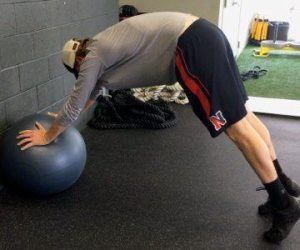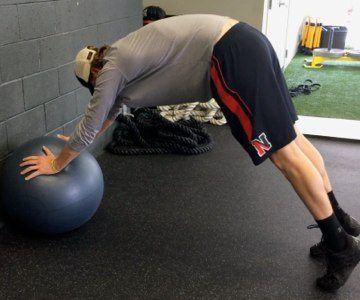
How to Perform the Yoga Stability Push Up
Here are a few of my coaching cues during the yoga stability push up:
- Place the stability ball up against a wall. The instability provided the ball is plenty, having the ball mobile isn’t needed and may not be safe. Also, don’t perform this on turf as it is sometimes hard to keep the feet from slipping.
- Start at the beginning plank position at the top of the push up. In this position prep you body by finding neutral spine and performing a mild abdominal brace. Keeping the core stable with enhance the mobility benefits at both the shoulders and hips.
- Perform a push up but on the push back up focus on your hands pushing up and out above your head to drive your hips up high. Protract your shoulders to perform a “push up with a plus.” Be sure to keep your core stable and hinge at your hips. You should feel both your abdominal area and glutes engage.
Benefits of the Yoga Stability Push Up
There are many benefits of incorporating the yoga stability push up into your routine. The three big things I am looking to improve with this exercise are:
- Shoulder and scapular stability. Performing a push up on an unstable surface has been shown to enhance scapular muscle activity compared to a traditional push up. This can also be said for the rotator cuff muscles.
- Serratus anterior activity. The push up with a plus includes both upward rotation and protraction of the scapula, the two motions of the serratus anterior that when performing together have been shown to enhance serratus activity.
- Hip mobility. By adding the downward dog yoga hip hinge portion of the exercise, you drive more elevation of the arms, but also help facilitate a hip hinge pattern.





